**Parts of this post are missing/non-functional due to my stupidity, sorry!**
This led me to think; why don’t I find the smartest, most experienced climber and simply do what they do? So I looked in highly regarded books, referenced anchor research, and read the opinions of experts in the fields of climbing and climbing physics. Surely all these smart people would eventually come to the same conclusion on best practices, right? Unfortunately not. Top resources will often give contradictory advice. One study will find a certain result and another seemingly reveals the opposite. Even if we somehow knew all the available information, our ability to apply it in the real world would be hampered by our imperfections as human beings and other factors encountered outside the lab.
In the remainder of this post I will do my best to outline the specific qualities of various anchors, references to the studies that investigate these qualities, as well as references to studies or factors that contradict or downplay these qualities.
The goal of this post to increase understanding of some anchoring concepts not as an attempt to explain all anchor constructions or considerations. Critical thought is required on the readers part to decide how to use this new information. This post is not for people new to anchor building; it will not discuss acronyms or attempt to give any instruction.
Warning: This post is not exhaustive; it is missing anchor types and considerations. I highly suggest reading the individual reference material and forming your own understanding. Furthermore, I am just a guy on the internet; don’t listen to me – USE YOUR BRAIN!
Table of Contents
1. Rule #1: What we can agree on.
This is as close to a flashcard answer as you are going to get. Read this!
A list of some of the terms we use in this post and why we use them that way.
3. Factors Affecting Load Distribution for All Anchors
AKA Why Equalization is a Myth. These factors are at play with all anchors, we discuss them here to avoid repeating ourselves when looking at individual anchors.
4. Stationary Master Point Anchors
An overall look at the research and considerations of these anchors and the following variations.
- Bight Legs
- Single Legs
- Mixed Legs
5. Sliding Master Point Anchors
An overall look at the research for these anchors and the following sub-types.
- Sliding X
- Equallette
- Quad
The answer you’ve been waiting for (but wont get).
Check these resources out! They are full of tons of interesting tidbits that didn’t make it into this post.
1. Rule #1BACK TO TOP
Rule #1: Use bomber anchor points*. No amount of rigging trickery can make a weak placement stronger[9]. Without a solid and secure point (preferably more than one) in your anchor your best bet is to bail**. If your anchor points are bomber in the direction they will see load it nearly doesn’t matter how you connect them but certain methods will deliver advantages in some situations.[3]
*If you do not know how to place and asses bomber anchors, get professional instruction and practice.
**You may be able to keep climbing, down climb, back clean, etcetera in order to build a suitable anchor. Do not get tunnel vision on what’s directly in front of you.
2. GlossaryBACK TO TOP
Anchor
A collection of multiple Anchor Points.
Anchor Point
A singular piece of protection (bolt, nut, cam, tree).
Anchor Leg
The part of the anchor connecting the Masterpoint to each individual Anchor Point. Also called Anchor Arm.
Anchor Side
Sliding Masterpoint Anchors have two Sides; each Side may contain multiple Anchor Legs (see photo)
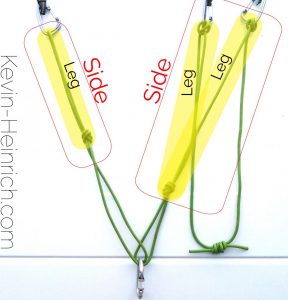
Direction of Pull
The direction from which the maximum anticipated load will come from. Anchors should be built with this in mind.
Distribution of Load
How well the anchor spreads force to the individual Anchor Points. Also called Equalization. The prefix “equal” is misapplied here as it suggests that Anchor Legs will see equal force which is NEVER the case[1].
Masterpoint
The connection point of the Anchor that optimizes strength, redundancy, and load distribution. Also called Focal Point.
Stationary Anchor
An Anchor whose Master Point is tied with a non-sliding knot. Such as a cordellete anchor tied with a figure eight on a bight; or a double length sling tied with a overhand on a bight. Also called Series Anchors[3], Sequential Anchors[3], Load Sharing[10], Non-Extending, Pigtail, and Pre-Equalized.
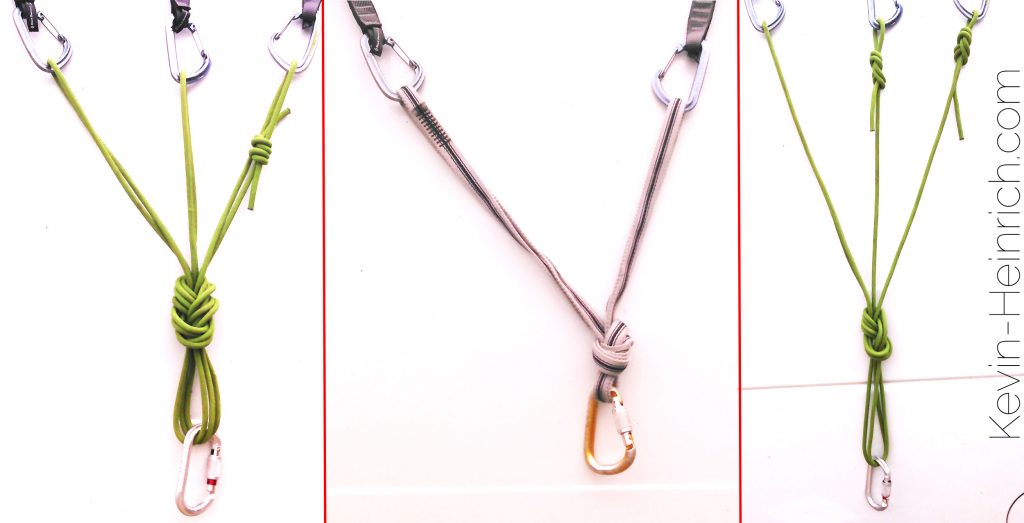
Sliding Anchor
An Anchor whose Master Point can slide and adjust. Such as a Sliding X, Equallette, or Quad. Also called Load Distributing[10], Self Tensioning[5], Dynamic Equalization[4], and Self-Equalizing.
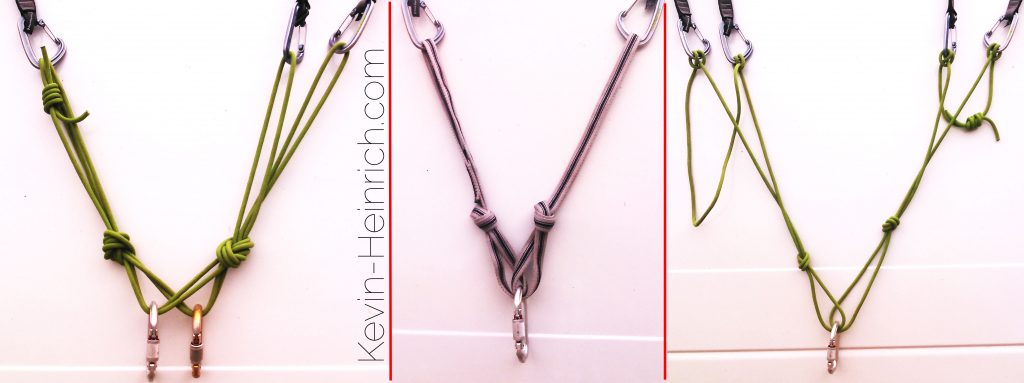
3.Factors Affecting Load Distribution in All AnchorsBACK TO TOP
Below are some of factors at play with all anchors and will affect their ability to share or distribute force between individual anchor points. It should become apparent thatequalization among the anchor points (meaning equal force on each leg) is practically impossible.
Changes in Direction of Pull
One anchor may need to handle many directions of pull between belaying the follower and the next leader; especially on traversing routes. Typically the direction of pull can be determined by looking at the first piece of gear the rope runs through when leaving the belay device. If there is no gear in the pitch the direction of pull will describe an arc as the climber falls into line below the anchor.[9] In high energy leader falls the belayer may be pulled upward against the anchor, this should be considered. When the Direction of Pull changes the geometry of the anchor will also change and slack will be introduced in anchor legs of stationary anchors AND sliding anchors with more than two points (see photo). Slack anchor legs are not distributed load.
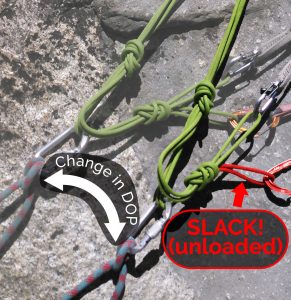
Length of Anchor Legs
Shorter legs in the anchor are loaded more than longer ones (see photo for a theoretical example). This is due to the available elongation. A longer leg can stretch more easily and therefore skews load onto the shorter leg.[3] This affect can be diminished by using a more static material such as Spectra/Dyneema, however anchoring with dynamic materials such as Nylon is recommended for improved force absorption.[3],[2] Static material can be used to reduce the amount of elastic material used in a long leg (see photo).
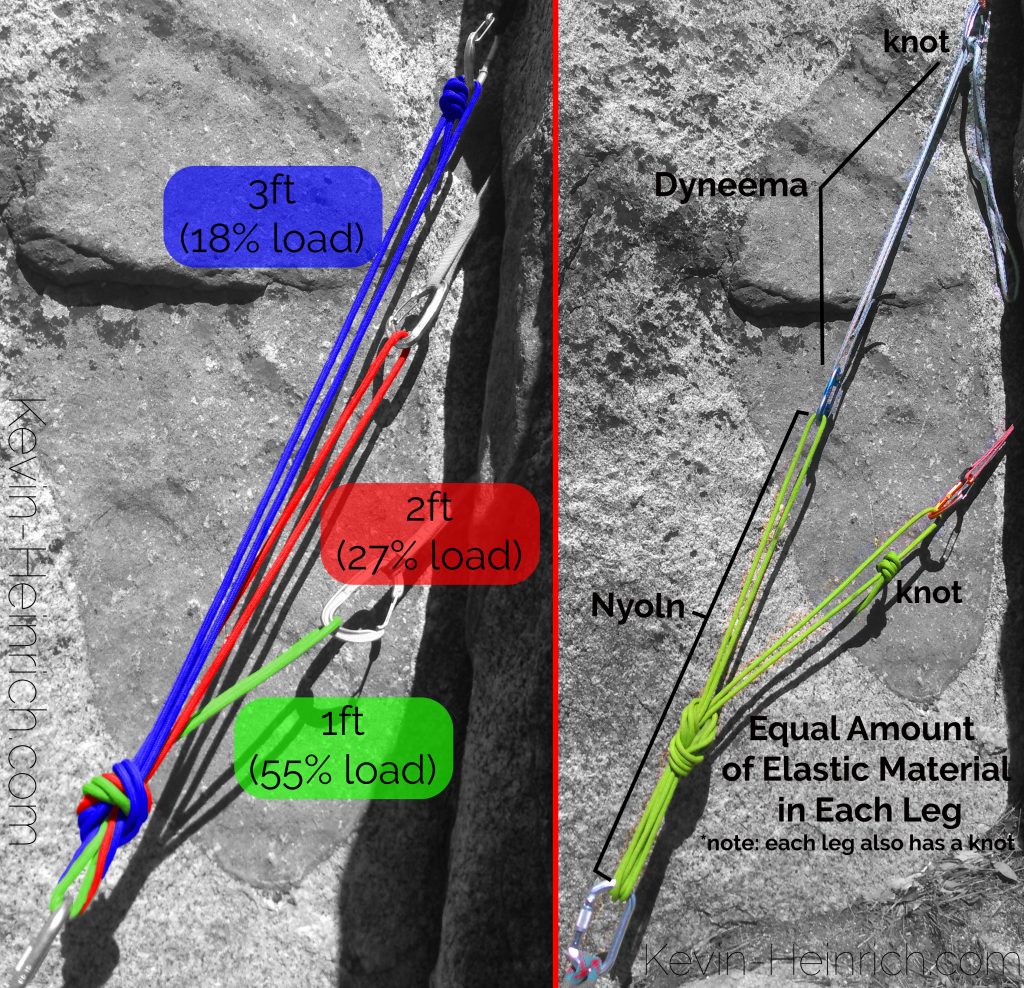
Strands in Anchor Leg
If they are the same length, a leg with two strands of material (a bight) will stretch less and therefore take more load than a leg with a single strand. This can be utilized to distribute more force onto a stronger piece or to decrease the elasticity of a particularly long leg to improve load distribution (see photo).
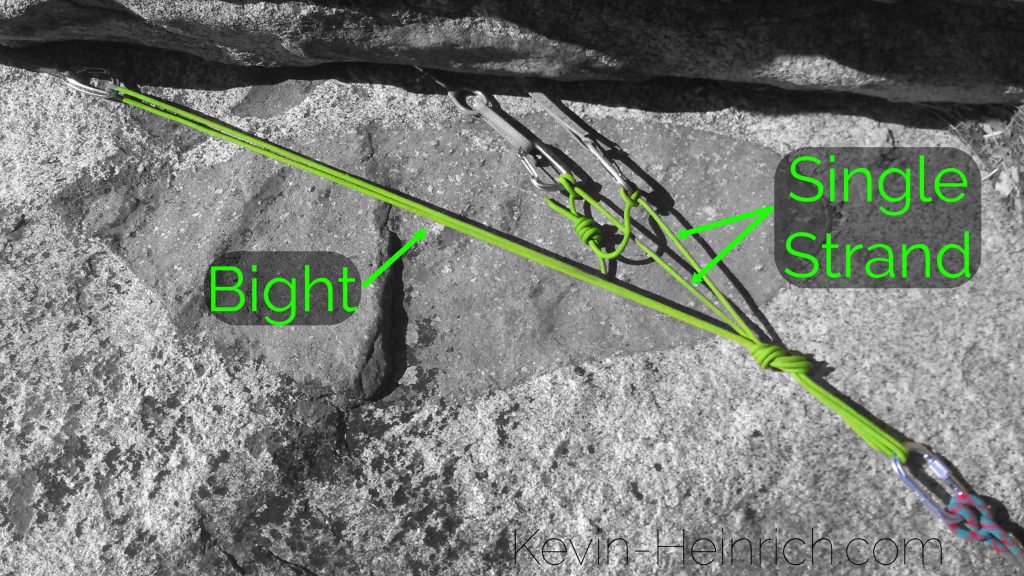
Knots in the Anchor Leg
A knot in the leg will compress and lengthen as it gets loaded making it more elastic and thus it diverts more load onto less elastic legs.[8] A un-tightened knot can be considered as slack in the anchor and has a significant effect on load distribution (more so than leg length).[2]
Angle Between Legs or Symmetry
If the load is not applied directly between the anchor points (i.e. the anchor is not symmetrical) it will put more force on the leg with the smallest angle relative to the load.[5]
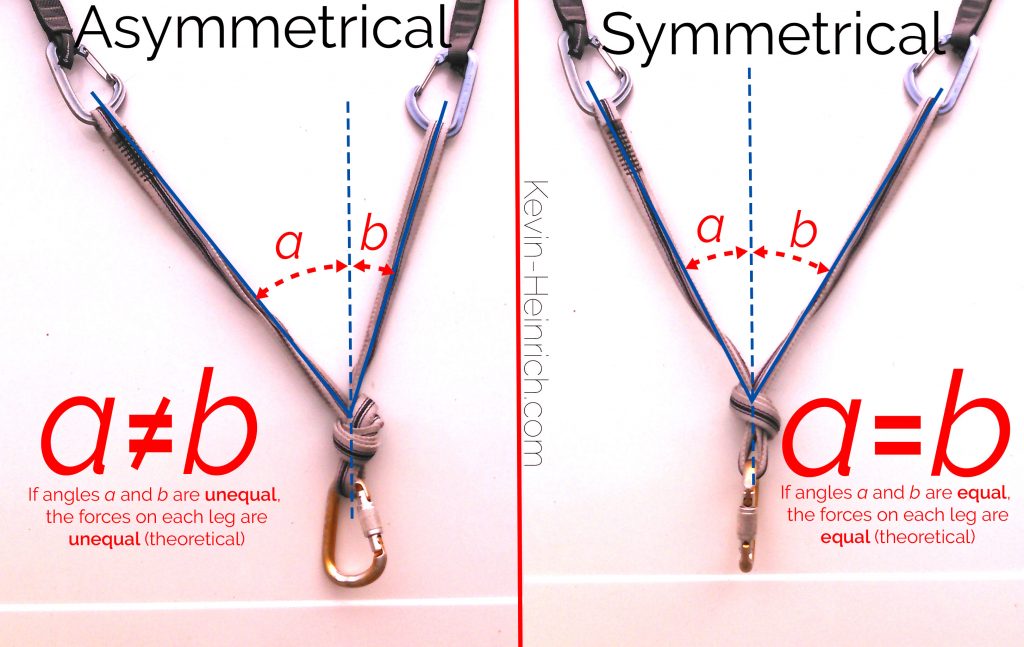
Number of Anchor Points (applies to Sliding Anchors)
A sliding anchor with three points doesn’t even theoretically distribute load equally as demonstrated in the image below. It’s also worth noting that anchor sides with two legs will behave as stationary anchors and will not adjust to changes in direction of pull.[3]
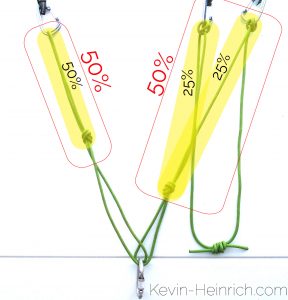
Friction in Master Point (applies to Sliding Anchors)
Sliding anchors rely on the masterpoint carabiners sliding freely to adjust to subtle changes in direction of pull; therefore friction makes these anchors less effective at distributing load. Anchors made with cord produce less friction than those made with webbing and thus distribute load better.[3] Further, sliding anchors using an “X” (Sliding X, Equalette) create more friction and distribute less than those that do not (Quad).
4. Stationary Masterpoint AnchorsBACK TO TOP
Advantages:
- Have little extension from anchor point failure which results in lower peak loading of remaining pieces compared to sliding anchors.[7] [10]
- Exceptions/Criticisms
- Can still extend when load causes point failure from un-anticipated direction of pull.[2]
- Exceptions/Criticisms
- Considerable load distribution with static loads, perfect direction of pull, and near equal leg properties (length, strands, presence of knots, etc).[10],[2]Performed better than sliding anchor types in two studies.[11],[6]
- Exceptions/Criticisms
- Static loading results are less applicable to the real world than dynamic load results. Sliding anchors performed better in dynamic events.[9][12]
- Perfect direction of pull may be unrealistic in the field. Studies showing good load distribution had ideal lab conditions but where still non-equal.
- Equal leg length is also unlikely in the field, however utilizing static materials (dyneema slings) to extend long legs may allow for more equal amount of dynamic material in legs of differing lengths.[2]
- Exceptions/Criticisms
- Easy to identify masterpoint.
Dis-Advantages:
- Direction of pull must be consistent and anchor must be ideally tied for this direction for load distribution to occur.
- Although good average load distribution under idealized conditions the distribution is highly variable[6]. Retying the same cordalette, on the same anchor points, and with the same direction of pull results in varying load distributions.[3],[6]
Individual Constructions
Bight Legs

Single Strand Legs

Mixed Legs
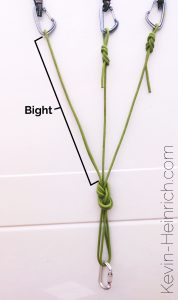
5. Sliding Masterpoint AnchorsBACK TO TOP
Advantages:
- More effective force distribution in dynamic loading than stationary anchors.[12],[9]
- Less variability in distribution behavior than stationary anchors.[9]
- Has the potential to distribute load to anchor sides through a range of directions of pull.
- Exceptions/Criticisms
- Despite frequent use of the term equal for these anchors, they are susceptible to all the factors affecting load distribution in stationary anchors, as well as the additional factor of masterpoint friction, and therefore do not distribute load equally or intuitively in the real world.
- Load will not be dynamically distributed between anchor points on the same anchor side. Anchor sides are effectively stationary anchors and legs will become slack/unloaded through a range of direction of pulls.
- Exceptions/Criticisms
- Doesn’t rely on practitioner’s ability to asses direction of pull.
Dis-Advantages:
- Subject to extension if anchor failure occurs. This may catastrophically load the remaining anchor point.[7],[12]
- Exceptions/Criticisms
- Extension can be limited with the use of knots, however knots also reduce the range of directions of pull.
- Exceptions/Criticisms
Individual Constructions
Sliding X (Basically a two-point Equallette)
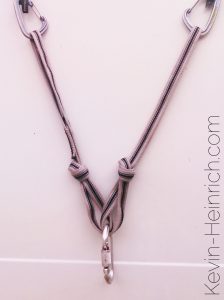
Equallette
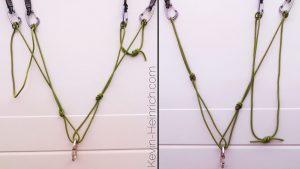
Quad
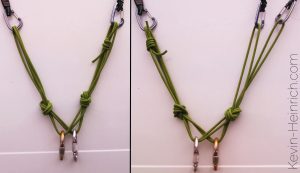
6. Conclusion BACK TO TOP
Where does all this information leave us? What anchor style is best to use? Of course you already know the answer: it depends. I’ll leave the reader to draw their own conclusions on the research above rather than share my opinion (which is really tempting!). Making judgement calls based on the situation ahead of us is part of what makes climbing so challenging, rewarding, and adventurous. I hope you learned something from this post and feel compelled to share it with your partners! The more climbers out there that think critically and challenge their own assumptions the safer we all will be! Oh, and don’t forget Rule #1: Place bomber gear.
7. Works Cited BACK TO TOP
[1] American Alpine Club, 2017, Anchors, (https://americanalpineclub.org/resources-blog/2017/7/31/anchors)
[2] Beverly, Marc, Attaway, Stephen, Scherzinger, Bill, Wilson, Scott, Modisette, David, Miller, Mark, 2005, Multi-point Pre-Equalized Anchoring Systems, (http://beverlymountainguides.com/wp-content/uploads/2016/02/Multi_point-pre_equalized-anchors.pdf)
[3] Chasse, Dick, 2016, Revisiting the Quad for Load Distribution and Stance Management,(https://rockandice.com/wp-content/uploads/Article-Images/Quad-Anchor-full-paper.pdf)
[4] Connally, Craig, 2004, The Mountaineers Handbook, Ragged Mountain Press
[5] DMM Climbing, 2013, Slings at Anchors, (https://dmmclimbing.com/Knowledge/September-2013/Slings-at-Anchors)
[6] Evans, Thomas, 2016, Equalization of Some Common Two Point Anchors Holding a Static Load, (http://sarrr.weebly.com/sar3-original-research/equalization-of-some-common-two-point-anchors-holding-a-static-load)
[7] Evans, Thomas, 2016, Peak Fall Arrest Force During Simulated 2-Point Multipoint Anchor Limb Failures, (http://sarrr.weebly.com/sar3-original-research/peak-fall-arrest-force-during-simulated-2-point-multipoint-anchor-limb-failures)
[8] Gibbs, Mike, 2012, Multi-Point Anchor Systems: Considerations for Equalization, (http://itrsonline.org/wordpress/wp-content/uploads/2015/03/Gibbs.Paper_.2012.pdf)
[9] Long, John, Gaines, Bob, 2013, Climbing Anchors, Falcon Guides
[10] McKently, John, Parker, Bruce, Smith, Cedric, 2007, A Look at Load-Distributing and Load Sharing Anchor Systems, (http://www.itrsonline.org/PapersFolder/2007/McKently-Parker-Smith2007_ITRSPaper.pdf)
[11] Owen, R., Naguran, S., 2004, Self Equalising Anchors: a Myth?, Technical Rescue Magazine 37:46-47, (14.cl/sitio/wp-content/uploads/2011/09/Self-Equalising-Anchors.pdf)
[12] Semmel, Von Chris, Hellberg, Florian, 2009, Stand in der Wand, Panorama 2/2009:74-77, (http://www.alpenverein.de/chameleon/public/ff2266c5-af0f-8770-3b87-d84038af4cfa/Panorama-2009-2-Standplatzbau-I_18404.pdf)

